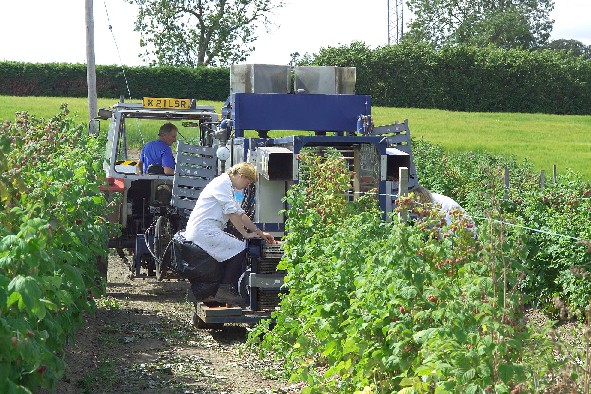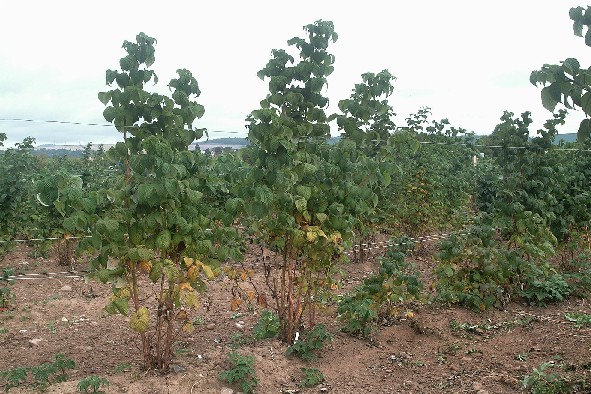- Background to the industry in Scotland
- History of raspberry breeding at The James Hutton Institute
- Breeding programme
- Breeding objectives
- References
Background to the industry in Scotland
Historically, raspberry production in Scotland has been for processing through preservation as pulp for jam manufacture, canning or freezing. However, since the early 1980s, the Scottish industry suffered a steady decline for a variety of reasons. The main causes being fierce competition from eastern Europe, keeping the prices low for Scottish growers, and disease, in particular raspberry root rot, caused by the fungus Phytophthora fragariae var. rubi. The UK fresh fruit market has shown rapid growth, and the increased consumption is forecast to continue. Although raspberry production for processing still exists in Scotland, current production is focused on the fresh market, in particular producing a crop under a protected cropping system. The advantages of protected cropping systems include season extension and improvement of fruit quality. Care is required in the selection of cultivars for use in these systems: for example, such changes in agronomic practices have implications for a shift in pest and pathogen pressures. The long cane production system provides an opportunity for selection of genotypes with a low chilling requirement, and a shorter flower to fruiting period.
Breeding selections in tunnels at The James Hutton Institute
History of raspberry breeding at The James Hutton Institute
Raspberries have been bred at Mylnefield since the 1950's and the development of cultivars crucial to the industry's prosperity has continued at The James Hutton Institute (formely SCRI) to the present time Jennings and Brennan 2002. The breeding programme was guided for many years by Derek Jennings followed by Ronnie McNicol and Rick Harrison. Nikki Jennings became the senior raspberry breeder in 2000. The raspberry breeding programme at The James Hutton Institute has been phenomenally successful and is perhaps best known for the 'Glen' series of cultivars which are grown throughout the world. The first of the series, Glen Clova, was released in 1970 and for many years was the mainstay of the raspberry industry, with yields 30% higher than the standard cultivars of the time. Glen Moy, released in 1981, was the first spine-free raspberry cultivar. SCRI-bred (now part of The James Hutton Institute) cultivars currently occupy 96% of the raspberry market in Scotland and Glen Ample, released in 1996, is the most widely grown raspberry cultivar in the UK at present.
Breeding programme
Commercial funding between 1993 and 2000 saw the breeding programme focus upon the development of machine harvestable cultivars for processing. However, it is the fresh market sector that now represents the main area for potential growth in both field and season extension contexts. The breeding programme maintains a broad germplasm base to meet the rapidly changing requirements of the UK raspberry industry. Although machine harvestable types are still under development, the primary focus is on the fresh market, selecting and developing cultivars suitable for production under a protected cropping system. Although breeding for agronomic traits remains a priority in any commercial breeding programme, a key objective of the Rubus breeding programme is to incorporate resistance/tolerance to pest and disease and make cultivars suitable for growing under integrated systems.  Raspberry harvester in breeding plots at The James Hutton Institute
Raspberry harvester in breeding plots at The James Hutton Institute
Currently, the funding for the breeding programme comes from the Scottish Raspberry Breeding Consortium, consisting of thirteen members from all sectors of the industry, including growers, propagators, marketing groups with underpinning funding from The Scottish Government.
Breeding objectives
Agronomic traits
The rapid rise in the protected cropping area in the UK has led to part of the selection process being conducted in polytunnels, constructed on-site at The James Hutton Institute. This will help in identification of adapted germplasm early in the selection process, prior to commercial trialling.
Pest and disease resistance
Crop losses due to raspberry root rot, caused by the fungus Phytophthora fragariae var. rubi infection, in Scotland are around 20%, and thus the development of varieties with resistance is of paramount importance Jennings et al 2003. This is the most destructive disease to affect raspberries in the UK. Currently, the few existing root rot resistant varieties lack acceptable fruit quality or yield. Part of the conventional crossing programme is targeted at developing tolerant cultivars with commercially acceptable agronomic traits. This is achieved by making crosses using parents with known existing resistance and screening the progeny in infestation plots at The James Hutton Institute. 
A progeny resulting from a cross between Latham (resistant) and Glen Moy (susceptible) were grown in field soil containing inoculum of Phytophthora root rot. Some plants are highly resistant (left) others are infected (right) and plants are eventually killed.
Future breeding plans with respect to Phytophthora resistance are underpinned by the development of molecular markers to improve and accelerate selection efficiencies. It is hoped that in future accelerated selection methods will help to produce promising resistant varieties.
The large raspberry aphid (Amphorophora idaei) is the vector for four major raspberry viruses. The source of aphid resistance comes from the single dominant gene A10. This confers resistance to four biotypes of the pest. Susceptible progeny are screened out early in the crossing programme, before planting. The development of varieties with strong aphid resistance is important because there are few sources of resistance to the aphid-borne viruses that could be readily selected for.
Although there is no screening for cane diseases such as cane botrytis, cane spot, spur blight and cane blight, very susceptible individuals that are identified in the field trials are eliminated during the breeding process.
References
Jennings SN, Brennan R & Gordon SC (2003) Commercial breeding for pest and disease resistance in cane and bush fruits. IOBC/wprs Bulletin, 26(2), 67.
Jennings SN & Brennan R (2002) Improvement of raspberry cultivars in Scotland. Acta Horticulturae 585: 179-183.
